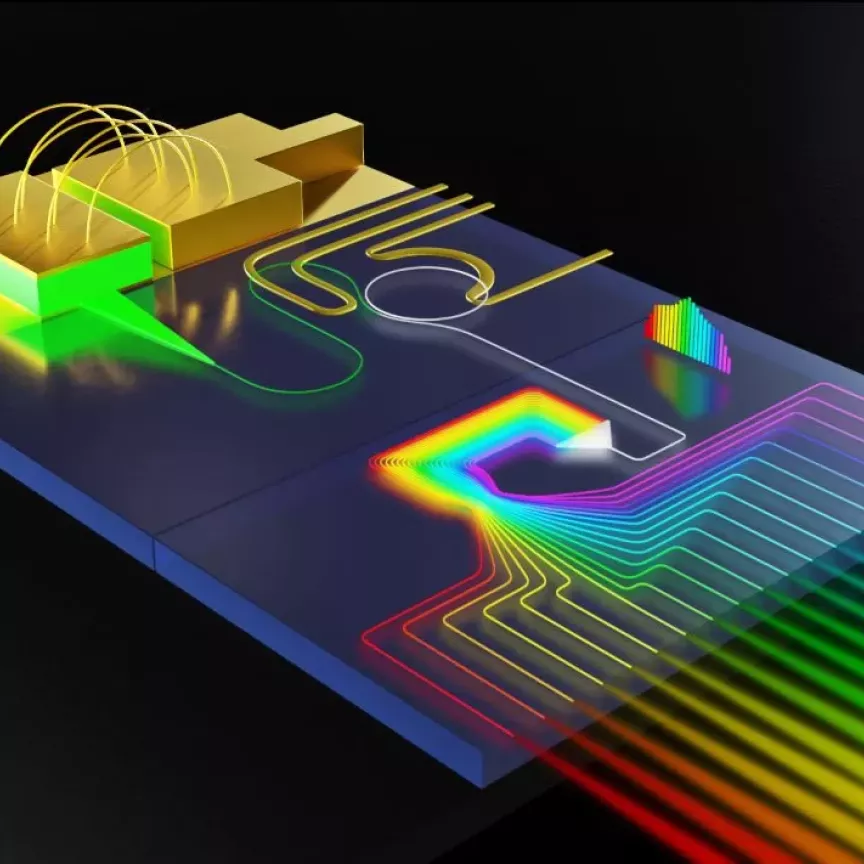Although laser diodes work very efficiently, they still convert only about 50 to 70 per cent of the current into light – the rest has to be quickly removed as heat. Depending on the power range, different systems are used for cooling – from simple passive air cooling to sophisticated active systems.
Since the output and the optical efficiency of a laser diode depend strongly on the operating temperature, it must be cooled to a temperature around 25°C. Since laser diodes are relatively small, this means that a large amount of heat must be dissipated and therefore even low-power emitters need a well thought-out cooling configuration.
With arrays of up to 25 individual diodes, this thermal generation can lead to a heat flux density of up to 5W/mm2. If the cooling is inadequate, the beam quality suffers and the emission wavelength shifts. In some instances, the laser diode will break down.
In order to optimise the heat transfer between laser diode and heat sink, the contact surfaces must be as even as possible. If large amounts of heat are to be removed, one often uses a heat spreader between the laser diode and the heat sink – such as diamond, which conducts heat five times better than copper.
Thus, the heat is quickly distributed over a larger area and then dissipated by a heat sink. However, there may be problems here because of the different thermal expansion coefficients between the diamond and the GaAs of the laser diode.
Above all, it is important that the heat sink thermally fits well with the laser chip. ‘Ours are usually made of a copper-tungsten alloy, which has almost the same coefficient of expansion as GaAs,’ says Dr Jörg Neukum, marketing director at Coherent-Dilas.
By heating in operation, the diode chip expands and stresses the solder layer that holds it on the cooling system – that’s why solders like tin, gold-tin, silver-tin and indium are used. Solder with gold-tin melts at 280°C (AuSn 80/20) and is particularly well suited for lasers in pulse mode.
But cooling systems are expensive and that’s why engineers at Coherent-Dilas, Jenoptik and two Berlin research institutes are working on new cooling techniques.
In the joint research project HotLas, funded by the BMBF (German Federal Ministry of Education and Research), the aim is to reduce the cooling effort. ‘This is necessary in order to increase the cost efficiency of the laser systems and to expand the application areas further. Furthermore, we are working on the implementation of novel concepts, such as to allow a smaller divergence angle of the laser diode even at higher powers – and thus to achieve a better coupling of the light into a fibre,’ reports Dr Ralf Hülsewede, from Jenoptik Diode Lab, the coordinator of the project.
The goal is the construction of a fibre-coupled diode laser module, which provides a continuous power of 200W, without internal cooling.
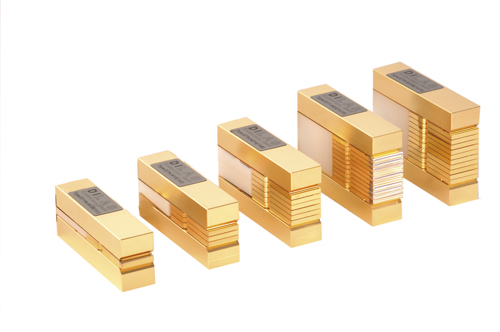
Coherent-Dilas' heat sink configuration
In general, the increasing power of laser diodes requires ever more efficient cooling systems.
‘There are basically two main types of cooling systems for diode lasers: Systems based on Peltier elements, i.e. thermoelectric cooling, and those based on liquid cooling, usually with water,’ reports Dr Konrad Laufs, business line manager for thermal management at Ams Technologies.
Peltier cooling works without water, reducing complexity and maintenance costs. However, Peltier cooling for low- to medium-power laser diodes requires large size heat sinks, as well as forced air flow over these heat sinks, such as by means of fans. However, if a laser diode is to be cooled to temperatures below the ambient temperature, Peltier cooling can only be used at very low cooling capacities and offers a very poor efficiency under these circumstances. But Peltier elements generally are inefficient and are accordingly not suitable for high-power laser diodes.
‘Peltier elements are less efficient than a compression refrigeration machine, but are typically more precisely controllable,’ notes Martin Traub, scientist at the Fraunhofer ILT. ‘Conventional high-power laser diodes are usually liquid-cooled.’
Jörg Neukum refers to the virtually maintenance-free, ready-to-use diode laser systems based on air or peltier-cooled diode laser modules: ‘The higher power systems with 200W, 400W and more, generate so much heat that water cooling is the most effective solution. This is designed for industrial water cooling, due to the use of heat-conduction-cooled laser diodes.’
Combining systems for efficient cooling
Laufs explains: ‘In liquid-based cooling systems, the laser diodes mostly sit on thermally highly conductive blocks through which liquids flow. For the resource-saving cooling of this liquid circuit, “recirculating chillers” – liquid circulating cooling units with a closed circuit and a heat exchanger – are used. These heat exchangers, in turn, are based on Peltier elements or use a compressor refrigeration cycle.’ A shoebox-sized chiller can thus provide up to about 200W of cooling power. Modern, particularly compact, models achieve about 400W of cooling capacity.
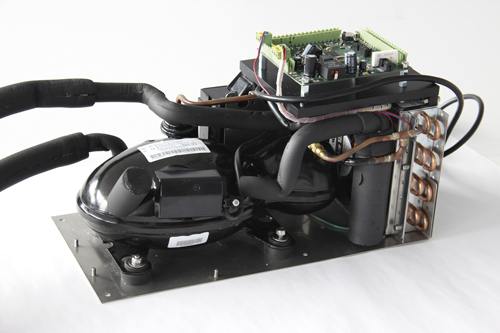
Cooling unit for direct evapouration with the linear compressor, the condenser heat exchanger and the electronic control. Credit: Ams Technologies
Another promising approach is based on direct evaporation. The compressor circuit is directly connected by means of flexible refrigerant hoses and the refrigerant is vaporised in a cooling plate (evaporator plate) or directly in the macro or microchannels of diode stacks.
‘This two-phase cooling can achieve higher heat transfer coefficients compared to single-phase water flow. Experiments have shown that a laser diode stack can be operated without further cooling channel optimisation at the same target temperature, with about 20 per cent higher output power,’ reports Laufs. For this purpose, the refrigerant is inert and erosion and corrosion does not exist. But to save the entire water cycle, the compressor cooling must be placed in the immediate vicinity of the diode laser.
The engineers work in the direct evaporation, both with linear compressor for operation at 24 V DC and cooling power between 0W and 300W, as well as with a model for single-phase AC line voltage, which can deliver up to 800W cooling capacity. So far, about 300W have been generated in Peltier cooling, and between 500W and around 5kW for circulating coolers.
For the thermal performance of microchannel coolers, the geometry of the micro-fins and their density on the surface of the cooling plates plays an essential role. Investigations have shown that the thermal resistance of an optimally designed microchannel cooling plate with 40 cooling fins per centimetre, compared to a simple tube cooling plate, is only about a quarter. Through a combination of microchannel cooling and direct evaporation, the thermal resistance drops again. In addition, the mass flow through the microchannel cooling plate is reduced to 10 to 25 per cent.
Combining microchannel cooling with direct evaporation, a heat flux of up to 250W/cm² can be achieved per base area of the cooling or evaporator plate, compared to a comparative value of about 100W/cm² in conventional single-phase water cooling under the same boundary conditions.
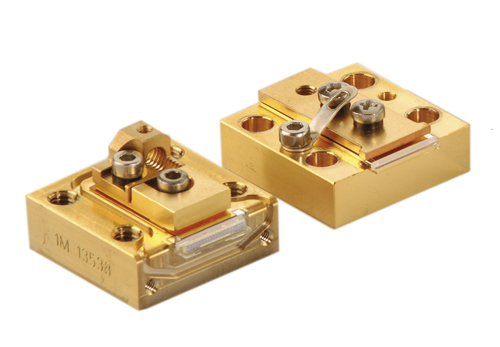
Passive heat sinks with micro-optics for collimation in one (FAC, fast-axis collimating) or two axes (FAC + SAC slow-axis collimation). Passive because in the solid copper block no cooling structures are integrated and the cooling is realised on the bottom by Peltier or water. Credit: Coherent-Dilas
Direct evaporation in conjunction with microchannel coolers offers great potential. Because the production of such microchannels has been very expensive so far, Ams Technologies is researching cost-effective alternatives.
New concepts for micro channel coolers
While traditional channels run through the block end-to-end, US firm Micro Cooling Concepts is experimenting with alternative configurations. A single column of micro-impingement channels can be aligned to cool a single emitter, with each channel having a very short flow path (<1mm) that makes a 180° turn below the emitter. An entire microchannel cooler typically cools 10 to 20 emitters.
Such a micro-impingement cooler combines impingement heat transfer with a variety of micro-channel designs. ‘We achieve thermal resistances of only 18Kcm²/kW,’ explains Geoff Campbell, from Micro Cooling Concepts, lead thermal designer and the developer of the process for fabricating the coolers.
Regardless of the particular internal cooling design, the cooling performance is determined firstly by the passage width of the channels. ‘We experimented with runs of up to 12.7µm, but our “normal” coolers have a minimum passage width of 25.4µm with a thermal resistance of 30Kcm²/kW at reasonable flow rates,’ says Campbell. A distinction is made between geometries in which the flow field of the coolant is oriented parallel to the heat flow as ‘micro-impingement’, and those in which the flow direction is perpendicular to the heat flow, i.e. parallel to the heated surface flows. The impact geometry can have an increased heat transfer coefficient.
Campbell already has plans for the future: ‘Our coolers have 1,000 passages per square centimetre with a diameter of 25µm. I think they could be made in the future using 3D printing. The problem right now is still the low resolution, but that could come in five to 10 years.’
Combi solutions are in demand
Since a laser diode or a stack does not work alone, multi-zone cooling may be appropriate. The cooling surface of the laser diode then has a very low thermal resistance and the cooling zones of the associated electronics larger cooling channels with a higher thermal resistance.
‘The coolant can be routed in series through the various zones, with each zone internally cooled in parallel by microchannels, or it is routed in parallel, with each zone receiving fresh coolant,’ reports Campbell. By adapting the cooling channels via the cooler, it is also possible to reduce thermal gradients in diodes, which are generally cooler at the end of the bars than in the middle.
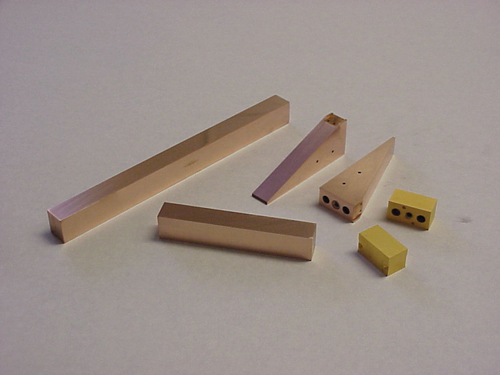
The coolers of different shapes offer 1,200 hours with only a modest increase in the flow rate of the coolers. Credit: Micro Cooling Concepts
On the one hand, microchannel coolers reliably dissipate heat. On the other hand, ‘with the copper the cooling water is surrounded by a very efficient electrical conductor. Without de-ionised water, with its low electrical conductivity and high electrical resistance, this will not work,’ concludes Traub. But the de-ionised water also corrodes the copper, which reduces the overall properties of the system.
Heat sinks are usually made of a good thermal conductivity metal, such as aluminium or copper, which are subject to corrosion by the coolant. A recent development is heat sinks made of ceramic materials, such as aluminium nitride. Occasionally, additional insulating layers of aluminium nitride are used, which separate the cooling water channels from the electrical contacts of the laser diodes, which, among other things, improves operational safety.
‘Until now, microchannel coolers have been produced by etching and oxidising structures in copper sheet, approximately 0.3mm thick. This reduces the melting point to 1,073°C.
‘Then the sheets [are packed] together and sent through an oven. The CuO melts and bonds the sheets,’ summarises Roland Dilsch, senior engineer at CeramTec Industrial Solutions.
He calculates that such a laser bar, with about 30,000 to 40,000 hours of life and costing in the order of €500 or more, is sitting on a cooler that has almost half the lifetime, but a cost of only about €30. So one would have to throw away something expensive because something cheap breaks too soon. ‘That is why we have structured ceramic foils of highly thermally conductive aluminium nitrite, packed them on one another and sintered them in an oven at 1,800°C. This gives a highly efficient cooler without corrosion problems,’ explains Dilsch.
There are other things to keep in mind when cooling laser diodes. Laser modules can be arranged both serially and in parallel. In the case of the serial arrangement, it should be noted that the water temperature rises with each laser module. The parallel arrangement has considerable advantages in terms of cooling.
It should be noted that in a parallel arrangement, the flow rate of each individual laser module is ensured and monitored.


